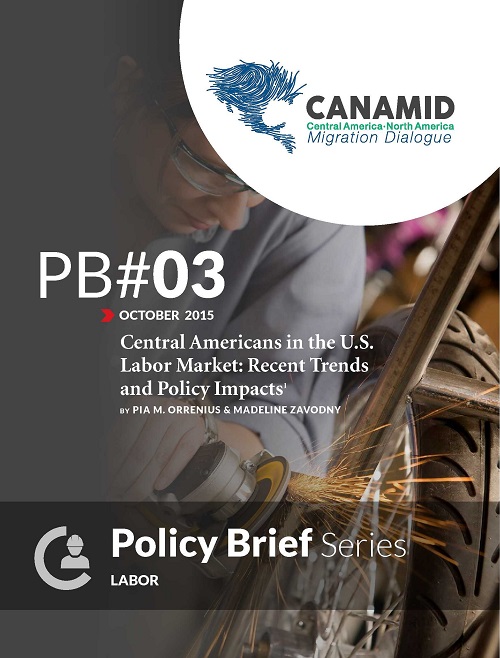 PB#03: Central Americans in the U.S. Labor Market: Recent Trends and Policy Impacts
Pia Orrenius and Madeline Zavodny
PB#03: Central Americans in the U.S. Labor Market: Recent Trends and Policy Impacts
Pia Orrenius and Madeline Zavodny
Immigration from Central America to the United States is rising rapidly. Much of this inflow is unauthorized. Violence and corruption in Central America is affecting both the volume and composition of current migrants who are less educated, less likely to speak English, and who face tougher border and interior enforcement than Central Americans who immigrated in the 1980s and 1990s faced. We offer a number of policy recommendations aimed at expanding legal avenues to accommodate immigrant flows from Central America while regularizing those already in the U.S.
 PB#04: Visitors and Residents: Guatemalan, Salvadoran and Honduran Workers in Mexico
Liliana Meza
PB#04: Visitors and Residents: Guatemalan, Salvadoran and Honduran Workers in Mexico
Liliana Meza
The labor status of Central American migrants is characterized by precarious work. This applies to both Guatemalans with temporary work permits who return to their country after a stay in Mexico as well as Guatemalans, Salvadorans and Hondurans living permanently in Mexico. This report is based on Mexico’s Southern Border Migration Survey (Emif Sur) 2004-2013 (Encuesta sobre Migración en la Frontera Sur de México) and the housing and population censuses from 2000 and 2010.
 PB#05: Access to health services for Central American migrants in transit through Mexico
René Leyva, César Infante, Edson Serván-Mori, Frida Quintino and Omar Silverman
PB#05: Access to health services for Central American migrants in transit through Mexico
René Leyva, César Infante, Edson Serván-Mori, Frida Quintino and Omar Silverman
Respiratory and gastrointestinal infections, dehydration, and injuries resulting from accidents are just some of the most common health issues suffered by irregular Central American migrants in transit through Mexico, who are perceived as a health risk to society.
 PB11# Honduran migrants in Mexico: From transit to settlement
Carmen Fernández Casanueva and María Teresa Rodríguez López
PB11# Honduran migrants in Mexico: From transit to settlement
Carmen Fernández Casanueva and María Teresa Rodríguez López
Migration is not a linear and sequential process. Migrants adapt their strategies and change their plans according to both obstacles and opportunities they face during their transit. Consequently, locations where migrants originally intended to simply pass through can become their destination (at least for a period of time). In this way, temporary locations can become more or less permanent.
 PB#14 Central American Migrants in Irregular Transit through Mexico: new figures and trends
Ernesto Rodríguez
PB#14 Central American Migrants in Irregular Transit through Mexico: new figures and trends
Ernesto Rodríguez
The number of irregular Central American migrants in transit through Mexico to the United States, mainly from Guatemala, Honduras and El Salvador - the Northern Triangle of Central America (NTCA) - has risen considerably over the past three years, totaling approximately 392,000 in 2014, just under the record set in 2005. The current flow almost tripled its annual average between 2008 and 2011, fluctuating around 135,000 migrants a year.